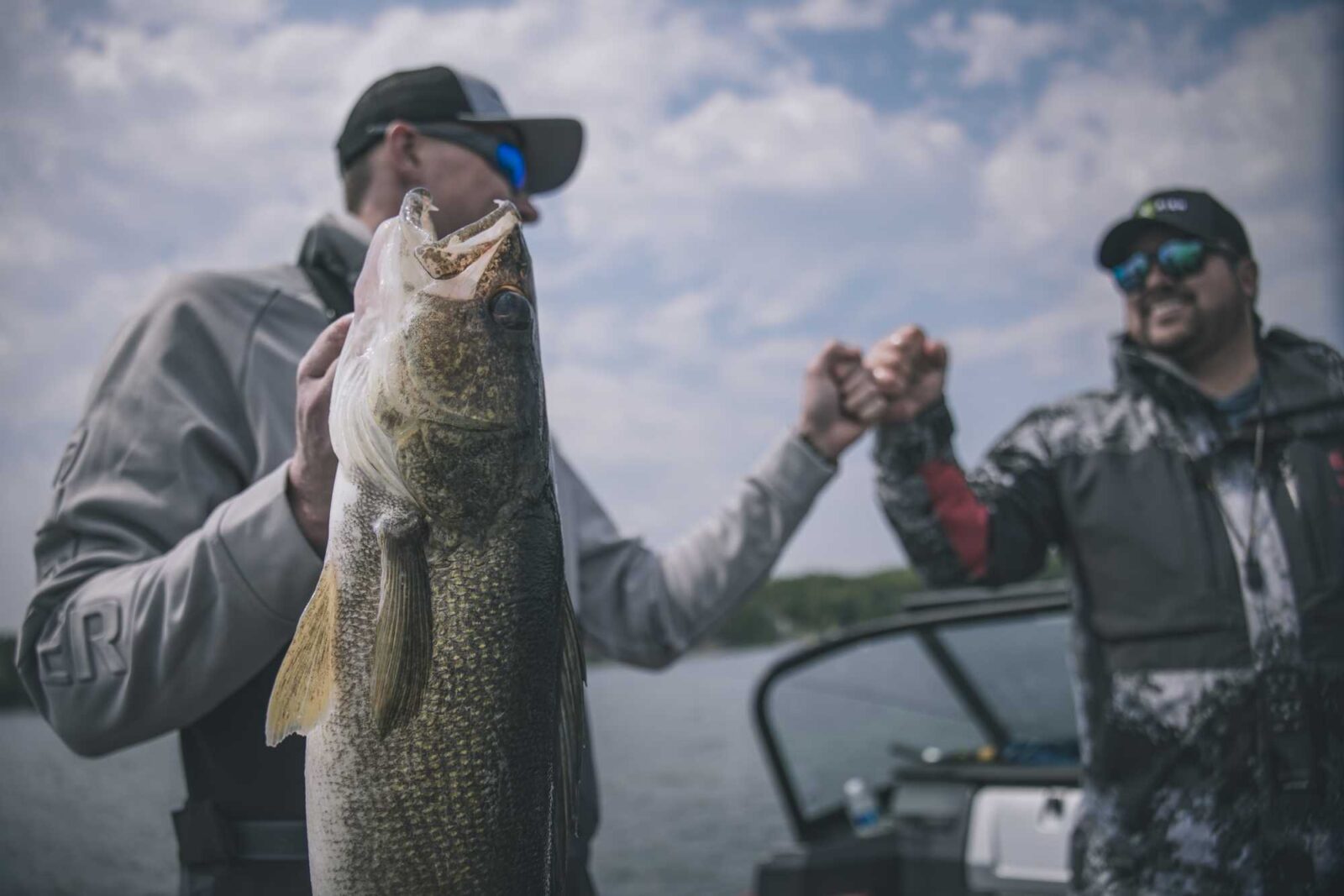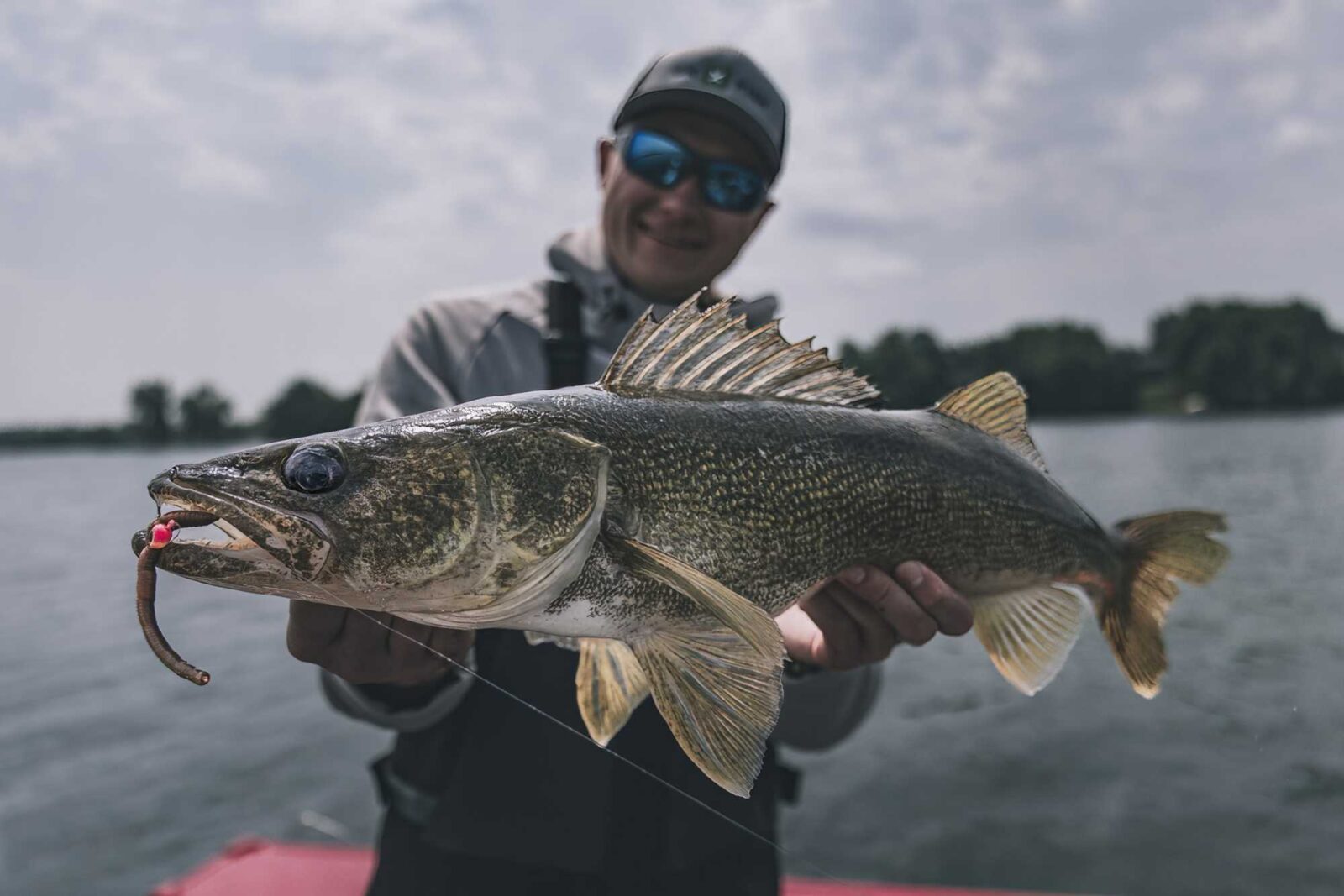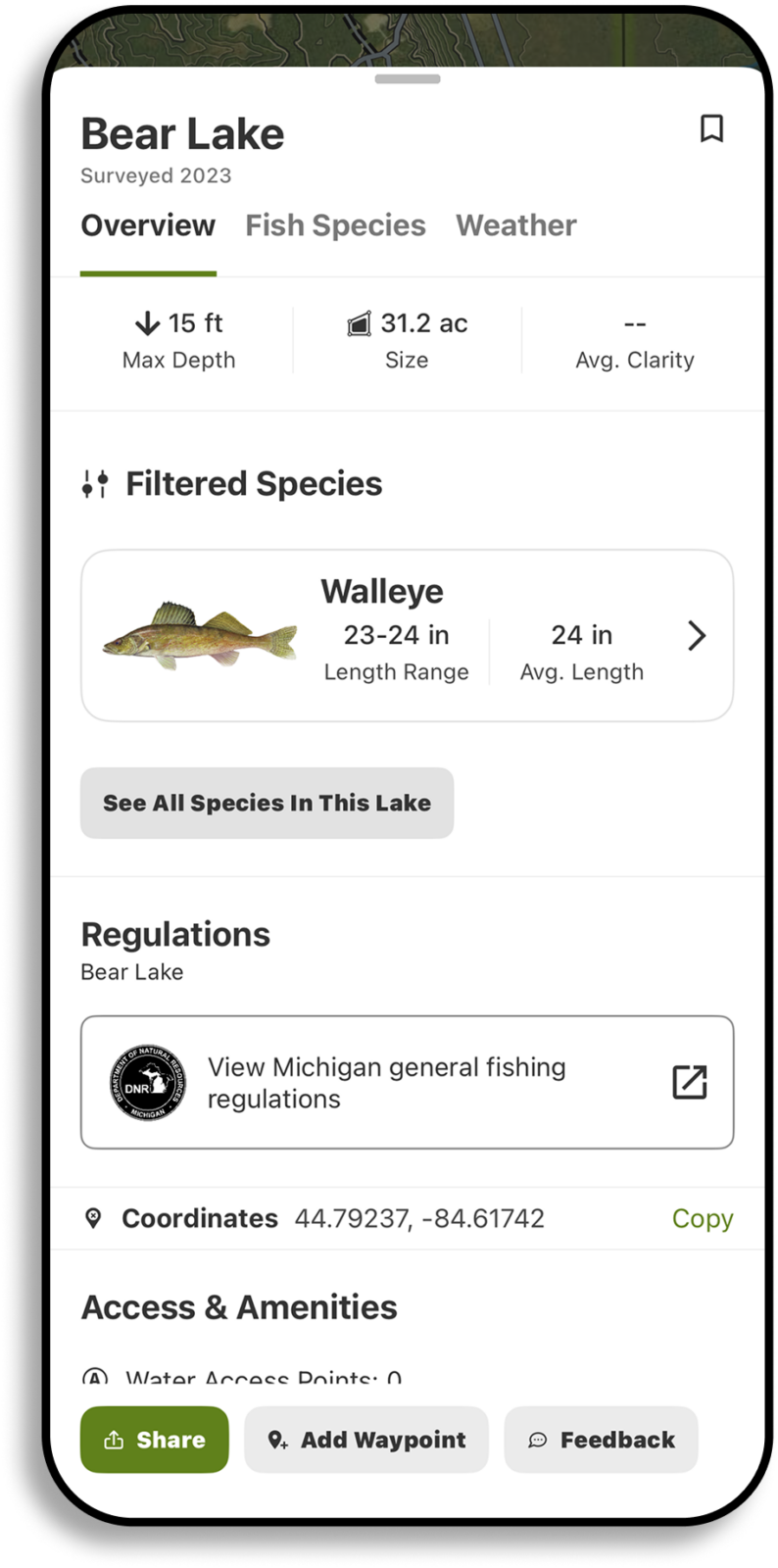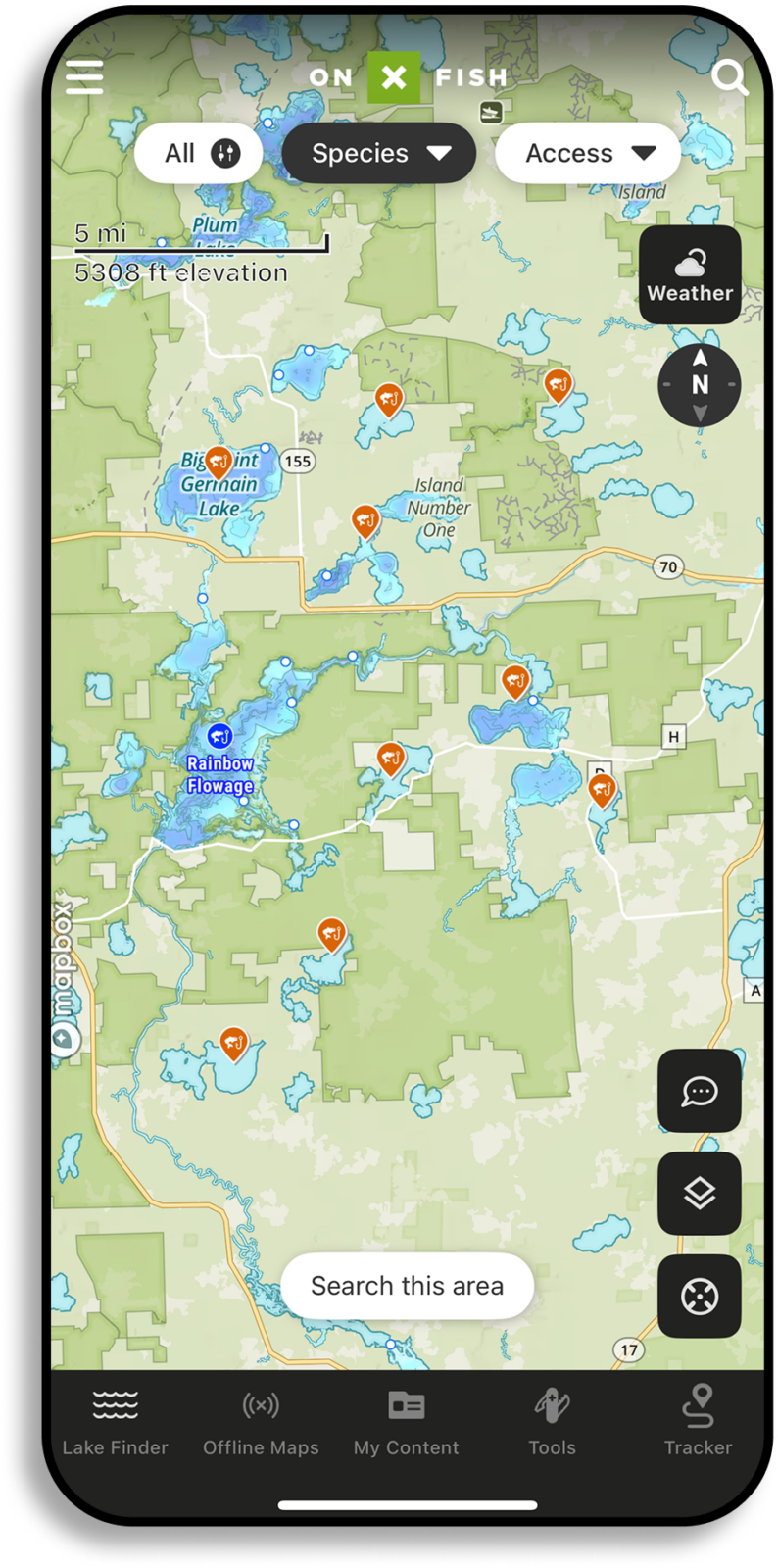Targeting Trophy Walleye: Top Midwest Lakes and Techniques
What Defines A Trophy Walleye?
Everyone loves catching a lot of fish, but there’s something really special about catching a trophy. What defines a trophy walleye? On most waters throughout the Walleye Belt, the consensus is that 30 inches comprises the magical mark, typically fish in the 10-pound range. But for avid anglers, a trophy could also be a “PB,” or personal best, that falls somewhere between 25 and 30 inches.
Why Trophy Walleyes Are Hard To Catch
Big walleyes are senior citizens that have seen it all and have become conditioned to commonly used presentations. On most waters, a 30-inch walleye is probably close to 20 years old (likely younger than that in warmer climates). That’s a long time spent averting anglers and learning lessons.
find the trophIes with Onx fish
Filter lakes based on factors such as fish species, their size, public access information, and even lake size.
Big walleyes are typically loners and spend much of their time over open water, although they will visit textbook structure to feed. This can make locating (and catching) trophy walleyes difficult. But there are ways to maximize your success hunting trophy walleyes.
TL;DR: A “trophy walleye” is commonly 30 inches / ~10 lb (many anglers also treat a 25–30″ PB as a trophy). They’re rare because big fish are old, picky, and often roam open water alone. Maximize odds by timing late winter/early spring and late fall, and fishing low light/night—especially around full moons. Use forward-facing sonar (FFS) to locate singles offshore, and keep presentations simple and subtle (light line, small natural jigs + live bait, dull jig colors). In fall—or when forage is large—upsize to match tullibees/shad (big cranks, swimbaits). Midwest trophy staples include Lake Erie, Detroit River, Saginaw Bay (MI); Green Bay, Winnebago, Mississippi River Pools (WI); LOTW, Rainy River, Mississippi Pools 2–4 (MN); Sakakawea, Devils Lake, Oahe ND section (ND). Use onX Fish: filter lakes by Trophy Potential, read species cards for big-year classes, save lakes, and build waypoints on reefs, points, humps, breaks—boosting time-on-big-fish.
5 Tips To Target Trophy Walleye

Tip #1: Fish When Trophies Are Active
Two things to keep top of mind when chasing trophy walleyes are time of year and time of day.
Time of Year
Late winter and early spring can be great times for big walleye chasers. Fish are pre-spawn and can be more easily found on some waters—and are more apt to eat. Same goes for the late-fall when big females start packing on calories given opportunistic baitfish runs or spawning. On waters like the Rainy River, giant walleyes are caught during the fall when emerald shiners run from the lake up the river. On other waters, the fall tullibee bonanza can be a big-fish feeding frenzy with trophies gorging on foot-long or better forage. Your chances of catching a trophy walleye are greater during these periods than during the height of summer.
Time of Day
Focus on the low-light periods of dawn and dusk, as well as nighttime, which often brings big walleyes out to feed, especially during the days immediately before, during, and after a full moon. Big fish use the absence of light (or minimal light) to their advantage, using their highly adapted vision via retinal cells called tapetum lucidum. Yes, walleyes are built to feed in the dark or very low light.
Tip #2: Use Your Electronics To Locate Big Walleyes
More big walleyes are being caught now than ever, largely due to the invention of forward-facing sonar (FFS). In fact, it’s become common in professional walleye tournaments for anglers to scour open water for the largest blips possible, signifying big, cruising walleyes—typically fish all by themselves and not grouped into pods. Tournaments have been won with this technique. If you adopt this approach, generally used early-summer through late-fall, make sure to handle your catch gently as mortality rises when fish are taken from cooler depths to warmer temps above.
Tip #3: Simplify Your Presentation

Along with the common tournament practice of scouring deep, open water for loner, big fish, many anglers have discovered that the best way to catch wise, old walleyes is to minimize the amount of hardware you put between yourself and the fish. That means light line and smaller, finesse jigs with live bait—anything from a leech, to a minnow or hunk of ‘crawler. Even color seems to matter. Most of these fish have seen or been hooked by glide baits and other presentations—even associating bright colors with some kind of historical stress. Pro walleye anglers have turned to jig heads that are devoid of color, are black, or have natural hues like olive green or green pumpkin. The same goes for hook size and shank length. Pros are using short-shank jigs to present their live bait, camouflaging as much of the method of delivery as possible.
Tip #4: Go With Bigger Presentations When Appropriate
During fall, you may want to size up your bait to match whatever the predominant forage is in the lake (e.g. spawning tullibees), which could have you fishing plus-sized baits that mimic the natural food. Large walleyes also eat their own, so upsizing any time of year can be advantageous, too. Yes, big fish will eat big stuff. Many 30-inch-plus walleyes are caught by muskie anglers slinging giant baits every year.
Top Waters in the Midwest for Catching Trophy Walleye
Michigan
Lake Erie
With millions and millions of walleyes across all basins of the lake, Lake Erie shines as a top trophy walleye destination. And given the amount of food in the lake, Lake Erie walleyes grow big, fast. Erie used to be a trolling game, but more anglers are using FFS to single out big fish rather than pick through a bunch of eaters, which also tend to be on the larger side in this lake.
Detroit River
Come spring, the Detroit River lights up with Erie-run walleyes making their move to spawning grounds. As such, it can be a haven for catching big fish. Given the river’s stiff current, most anglers vertical jig with ounce or better jigs, typically tipping them with plastics like the local favorite, Wyandotte Worm.
Saginaw Bay
Although there are walleyes to be caught here all year ‘round, trophy hunters focus on October through December when trophy fish push in to gorge on shad. Lipless crankbaits catch tons of fish here, as well as trolling Husky Jerks and Bandits.
Wisconsin
Green Bay
The best time to fish is early spring when walleyes begin entering the bays and rivers like the Fox, Oconto, and Menominee River to eventually spawn. Fish can be caught on jigs, cranks, and a lot of different presentations, with great probability of hooking up with a trophy.
Mississippi River Pools 4, 5, 9
Whether you’re fishing open water during the winter, early spring, or fall, Mississippi River Pools 4, 5, and 9 present great opportunities to catch trophy-class walleyes with fish occasionally breaking the 14-pound mark when filled with eggs. All your classic walleye techniques will work: jigging, pitching, blade baits, Dubuque Rigs, 3-Way rigs, etc.
Lake Winnebago
While known for its sheer abundance of respectable year-class fish, the Winnebago system also turns out some monsters. Trolling and jigging the lake’s reefs or shoreline structure is common among anglers catching 30-inch fish every year.
Minnesota
Lake of the Woods
Covering just over 1,500 square miles, Lake of the Woods (LOTW) is a border water shared by Minnesota and Ontario. And it’s filled with a lot of walleyes, most frequently fished by anglers seeking limits of eaters. There are some giants in the system, given the sheer amount of food and real estate. From jigging to trolling, countless trophy walleyes are caught on LOTW every year.
Mississippi River Pools 2-4
From the metropolitan area of Minneapolis-St. Paul, all the way down to Lake Pepin, trophy walleye opportunities abound. For starters, Pool 2 is a designated catch and release area, so the area is known for producing big fish, especially during open water winter periods, early spring, and fall. Most anglers choose to jig or pitch plastics in this stretch. Farther down from Hastings, near Red Wing, is Pool 3, which also produces big fish. Pool 4, from the dam near Red Wing to Lake Pepin, produces a lot of trophy fish each year by the same methods during relatively the same times on the calendar.
Rainy River
Not sure of the trophy density on LOTW? All one has to do is fish the spring run on the attached Rainy River, which runs from Baudette to International Falls, to find out. With thousands turning out for the annual spring catch and release-only season, social media gets littered with images of fish from 10 to 14 pounds. But that ends the second week of April each year. Don’t fret, though, the river opens to fishing following the spawn, and each fall, big walleyes follow emerald shiners back up the river for what can be another great shot at a true trophy.
North Dakota
Lake Sakakawea
Spanning over 360,000 acres, Lake Sakakawea is North Dakota’s crown jewel for walleye fishing. With an expansive forage base and sprawling habitat, this Missouri River reservoir consistently produces trophy-class walleyes. Anglers here often target depths of 10 to 25 feet, especially near submerged structure and drop-offs. From the Van Hook Arm to the east end near Garrison Dam, spring and fall are prime seasons to find giants, with popular techniques including trolling crankbaits or slow death rigs along contour lines. The lake’s vastness can be intimidating, but it regularly rewards those willing to explore.
Devil’s Lake
Devils Lake has grown in both size and reputation over the years—and so have its walleyes. Known for its flooded timber and submerged roads, this body of water offers a unique, structure-rich environment where big fish lurk year-round. Spring and early summer find trophy fish shallow, with anglers pitching jigs and plastics into flooded willows and cattails. In mid to late summer, many shift to trolling or bobbering over submerged rock piles and roadbeds. Devils Lake is a multi-species destination, but for serious walleye hunters, it remains one of the best bets for a double-digit walleye.
Lake Oahe (North Dakota Section)
Often overshadowed by its South Dakota counterpart, the northern stretch of Lake Oahe offers exceptional trophy walleye opportunities with less pressure. This Missouri River reservoir features classic walleye structure—long points, deep channels, and sprawling flats. Anglers targeting larger fish key in on slower presentations like bottom bouncers with spinners or live bait rigs during the summer months. The area near Beaver Bay and Prairie Knights Marina is especially productive. With less competition and a healthy population of baitfish, this part of Oahe quietly produces some of North Dakota’s biggest walleyes.
Use onX Fish To Scout and Save Big Walleye Spots

Scouting potential big walleye spots is made much easier for anglers with the help of onX Fish.
Fish Where They Are: First, use the “Trophy Potential” filter to identify lakes with large walleyes according to the most current state department of natural resources (DNR) fisheries data. You will notice an icon on all lakes within your state that hold big walleyes.
Dig In: Details in the lake/river and species card can confirm walleye recruitment—especially key year classes moving up. When walleyes over 28 inches are sampled year after year, you’ve found a great trophy walleye factory.

Save That Spot: On the lake card, click the banner in the upper right-hand corner to save this lake as a favorite in “My Content.”
Study the Map/Develop Waypoints: Dial into the lakes or rivers of interest and investigate access points, and depth/structure contours (reefs, points, humps, deep breaklines, etc.) that may hold big fish. You can develop Waypoints from Fishing Hotspots data suggestions, as well as your own. Here’s a hint: Use Recent Imagery layer to find even more potential big fish locations.
Find trophy Walley Lakes near you
Generally 30 inches (~10 lb); many anglers count a personal best (25–30″) as a trophy on their home water.
Forward-facing sonar (FFS) lets you scan open water for single, large returns and make precise presentations—key from early summer through late fall.
Use Trophy Potential to flag big-fish lakes, read species cards for >28″ year-class trends, save promising waters, then map access + structure (reefs, points, humps, deep breaks). Add waypoints (incl. Recent Imagery and Fishing Hotspots) to build a big-fish plan.